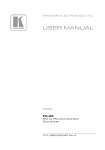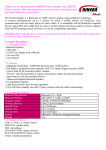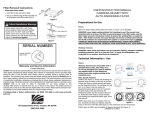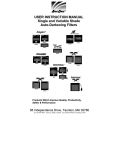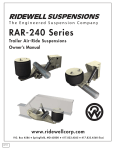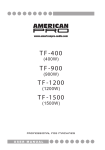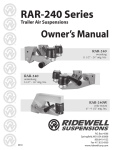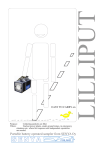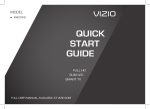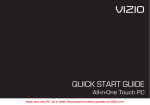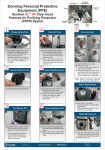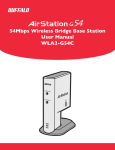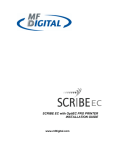Download PAPR User manual.indd
Transcript
USER INSTRUCTION MANUAL POWERED AIR PURIFYING RESPIRATOR • COMFORTABLE • LIGHTWEIGHT • PORTABLE • POWERFUL • DURABLE Products Which Improve Quality, Productivity, Safety, & Performance WELDING AND SAFETY PRODUCTS 85 Independence Drive, Taunton, MA 02780 Instruction Manual P/N M-CA-WD-02 Rev B Definition of Safety Signal Words per ANSI Z 535.4 Indicates a potentially hazardous situation which, if not avoided, could result in death or serious injury. Indicates a potentially hazardous situation which, if not avoided, may result in minor or moderate injury. It may also be used to alert against unsafe practices. Do not use this product until you have read and understood this instruction manual which is an essential part of the COMPACT AIRTM PAPR System. If the equipment is not properly assembled, connected, and used in strict conformance with this instruction manual, contaminated air could be drawn in the System, resulting in exposure, which may lead to serious bodily injury or loss of life. Use by unqualified or untrained persons, or use other than in accordance with this instruction manual, is dangerous and could expose you to serious bodily injury or loss of life. 1 Table Of Contents 1.0 General Information 1.1 1.2 1.3 1.4 Introduction Principal of Operation Respirator Approvals Helmet Approvals 2.0 System Use and Maintenance 2.1 2.2 2.3 2.4 2.5 2.6 2.7 2.8 Preparation for Safe Use Filter Cartiridges Battery Charging Air Flow Test Welding Helmet Assembly Pre-Operational Inspection and Donning Troubleshooting Guide Maintenance and Storage 3.0 Component Replacement 3.1 3.2 3.3 3.4 3.5 3.6 Blower Unit Replacement Fuse Replacement Face Seal Replacement Airduct Headgear Assembly Replacement Breathing Tube Replacement Auto-Darkening Lens Replacement 4.0 Customer Information 4.1 Replacement Parts and Accessories 4.2 Technical Specifications 4.3 Warranty 4.4 Warranty Registration Card 4.5 Customer Service 4.6 Servicing Appendix I - Respirator Approval Label Appendix II - Filter/Cartridge Approval Label 2 by AIR FLOW DIAGRAM A complete Compact AirTM PAPR System Includes: • A Choice of Lightweight and Durable Nylon Eagle, Hawk, Vision, or Fiberglass Falcon Welding Helmet • • • • • • • • • • 3 A Choice of Auto-Darkening Welding Lens Air-O Dynamic Airduct Headgear with Sweatband ComfaSealTM Face Seal (not shown) Three HE Particulate Filters or Three HE/OV/SD/CL/HC Cartridges Blower Unit Airflow Indicator (not shown) 4.8V NiCad Battery and Charger Breathing Tube Adjustable Belt (not shown) Carrying Case (not shown) Available in the following Helmet Styles with a choice of Auto-Darkening Vision Series Helmets Industrial TM Shades TM Singles ® Variable Shade Selections 9-13 & 7-14 Variable Shade Selections 9-12 Shade 9,10,11 or 12 5 x 4” Fixed Front or 2 x 4” Fixed Front 2 x 4” Lift Front 5 x 4” Fixed Front 5 x 4” and 2x4” Fixed Front Eagle Series Helmets (4 x Industrial TM Shades TM Singles ® Variable Shade Selections 7-14 Variable Shade Selections 9-12 Falcon Helmet (5 x 4) Shades TM Singles ® Shade 9,10,11 or 12 Industrial TM Variable Shade Selections 7-14 Variable Shade Selections 9-12 Hawk Helmet (2 x 4) Singles ® Shade 9,10,11 or 12 Industrial TM Variable Shade Selections 9-13 4 1.0 General Information 1.1 Introduction Congratulations! You have purchased the ultimate in comfortable welding powered respiratory protection equipment manufactured in the world today. The complete COMPACT AIRTM Powered Air Purifying Respirator System is offered in three distinct lightweight welding helmets: the Eagle, Hawk, Vision, and Falcon, which include ArcOne’s family of electronic auto-darkening filters. (Enclosed is ArcOne’s Auto-Darkening Welding Helmets “User Instruction Manual,” please refer to that manual for details on ArcOne’s welding The Compact Air Powered Air Purifying Respirator System blows a supply of filtered air over the welder’s face, creating a protective positive pressure inside the face collar, that keeps out harmful gases, vapors and particulates, and offers additional comfort when working conditions are hot and humid. Our goal is to make your demanding job comfortable and safe. The Compact Air PAPR system is not only engineered for safety and functionality but also for lightweight comfort. You can wear the Compact Air PAPR system all day with no worry of fatigue or respiratory stress. To assure your complete satisfaction with the Compact Air PAPR system, we ask that you read these user and safety instructions thoroughly before using the system.PLEASE, also take the time to read the Auto-Darkening Welding Helmets- “User Instruction Manual” which is enclosed. The complete Compact Air PAPR System has been engineered for: TOTAL PROTECTION to the welder - (1) COMPACT AIRTM POWERED AIR PURIFYING RESPIRATOR - Filters the air that a welder breaths into his or her lungs. (2) ARCONE’S AUTO-DARKENING LENS - Protects the eyes, and prevents against neck injuries (3) EAGLE, HAWK, VISION, and FALCON SERIES WELDING HELMETS - Ergonomically designed to protect the face, head, and neck areas during welding. 5 1.2 Operating Principals This Compact Air PAPR system is used in a welding environment where protection is required against harmful particles, mist, vapors and gases. The Compact Air PAPR , in conjunction with ArcOne’s Auto Darkening Lens and Eagle, Hawk, Vision, and Falcon welding helmets eliminate much of the wasted motion and discomfort associated with welding. You will receive a constant flow of fresh air, which will allow you to comfortably remain safely in your work environment for a longer period of time, and is of particular benefit where working conditions are hot or humid. The Compact Air blower unit supplies an over capacity of (170 Liters) per minute of filtered air to the welding helmet, and allows the user to breathe without having to overcome the resistance of the filters. Considering that an adult person requires an average of 45 liters of air per minute, the over capacity ensures a slight overpressure and thus a high degree of protection. The Compact Air PAPR system is powered by a rechargeable NiCad battery, which is encased in durable lightweight plastic. A clip is provided for easy and secure attachment to the adjustable belt. The battery provides protection for an 8 hour shift. The battery is delivered in the uncharged state; the charging time for a fully discharged battery is 14 hours. (See Section 2.3 Battery Charging) The Compact Air blower unit should be fitted with filters appropriate to the application and selected by a competent person with a full knowledge of respiratory hazards, and their concentrations that are applicable in the workplace. To ensure adequate protection, it is essential that the blower unit is correctly configured and that the correct filters are used. (See Section 2.2 Filter Cartridges) If there is any doubt of final determination of respirator applicability and filter selection, it must be made by an on-site safety specialist or industrial hygienist. (or contact the National Institute of Occupational Safety and Health). 6 1.3 Respirator Approvals The Compact Air PAPR System as described in this instruction manual has been approved by the following agencies • • NIOSH 42 CFR Part 84 (USA) CE - EN 146 and EN 147 (Europe) 1.4 Helmet and Auto-Darkening Lens Approvals The ArcOne helmet, consisting of the Eagle, Hawk, Vision, and Falcon series and the full family of ArcOne’s Auto-Darkening Lenses have been tested and approved under the following Standards Agencies (see specific models for standards that apply): • • • ANSI Z87.1 - 1989 (USA) CSA Z94.3-M88 (Canada) CE - EN 374/EN 175 (Europe) 2.0 System Use and Maintenance 2.1 Preparations for Safe Use Before using the Compact Air PAPR System, you should ensure that all conditions for safe use have been satisfied. • • • • 7 The space in which the Compact Air PAPR system is to be used must contain at least 19.5% oxygen and must not contain any explosive gases or vapors. In enclosed spaces where there is a risk of oxygen deficiency, use of the Compact Air system should be avoided. Check before use that the free flow of air is not obstructed by blocked filters or other causes. Check that the correct filter cartridges have been selected. Check that the Compact Air PAPR system is working properly by means of the flow meter supplied. (See Section 2.4 Air Flow Test) 2.2 Filters/Cartridges Before connecting the filter to your Compact Air PAPR System, read the NIOSH approval labels found enclosed with the filter/cartridges. Different types of filter cartridges must be used according to the nature of the particular hazardous substances to be encountered. (SEE BELOW) Filter Media: HE - High Efficiency Particulate Air Filter for Powered Air Purifying Respirators - time use restrictions apply. Approved for respiratory protection against Particulate Aerosols. NOTE: HE FILTERS SHOULD NEVER BE WORN FOR PROTECTION AGAINST GASES OR VAPORS. REFER TO SPECIFIC NIOSH FILTER APPROVAL LABELS FOR SPECIFIC INFORMATION ON USAGE AND LIMITATIONS. HE/OV/CL/HC/SD - Combination Cartridges Approved for respiratory protection against Chlorine or Hydrogen Chloride or Sulfur Dioxide or Organic Vapors and /or Particulate Aerosols. NOTE: REFER TO SPECIFIC NIOSH CARTRIDGE APPROVAL LABELS FOR SPECIFIC INFORMATION ON USAGE AND LIMITATIONS. • Always fit three (3) identical cartridges to ensure an evenly distributed airflow. A different or older type of cartridge may “Break Through” sooner rendering the filter action of the Compact Air System Totally Ineffective. • • Used filter cartridges CANNOT be cleaned. ALWAYS replace filter cartridges with new ones, if in doubt. DO NOT overtighten the filter cartridge. Overtightening could result in distortion or displacement of the seal allowing contaminated air into the system, resulting in serious bodily injury or loss of life. • Remove the screw caps from each of the filter cartridges and retain them in a safe place for later use. Ensure that the filter cartridge threads are clean. Check to make sure that there is a rubber O-Ring inserted into each inlet before screwing the filter loosely into each of the three inlets. When all three filters are in place, hand tighten them so that an airtight seal is achieved between the neck of each of the filter cartridge and the threaded sockets of the blower unit. • A plastic plug (depending on the type of filter cartridge used) is supplied with each filter cartridge. Ensure that the plug is removed before using the system. (See Figure 1). Keep the plugs in a safe place for later use. Blower Unit Cap Plug Filter Media FIGURE 1 9 2.3 Battery Charging The battery is supplied in an uncharged state; the charging time for a fully discharged battery is 14 hours, using the Battery Charger. If the batteries are repeatedly charged after partial discharge, it will shorten their life. To prevent this, the battery can be fully discharged by connecting it to the blower unit; turn the blower unit on and let the battery drain completely. Under normal circumstances the battery can be charged and discharged approximately 500 times. • Connect the battery to the charger by plugging the charger lead into the top of the battery, gently twist clockwise to secure connection, this will prevent the lead from slipping out of the socket. (See Figure 2). • Ensure that the fuse is in place, you will find the fuse contained with the fuse holder cap, which is located on the right side of the battery. Simply unscrew the cap holder for access to the fuse. The position of the button switch on the battery is not important. (See Section 3.2). • Plug the charger into a suitable source of AC power (110-120 VAC). • The battery should be charged for the FULL 14 hours. Charger Insert and Twist Clockwise Fuse Battery On/Off Button Switch FIGURE 2 10 2.4 Air Flow Test In order to assure that the Compact Air PAPR is operating properly the following Operational Inspection should be performed with the provided flow meter. • If any components are missing or damaged, replace them prior to using the • • • • • Compact Air PAPR system. Ensure that the filter cartridges are fitted properly into the blower unit. Confirm that the battery is fully charged (See Section 2.3), the power lead from the blower unit is plugged into the battery, and the plastic plug has been removed from all the filters. Check the blower unit and filter airflow as follows: At the end of the breathing tube, (the end of the breathing tube that is connected to the welding helmet) insert the base of the airflow indicator vertically into the breathing tube. Turn the battery ON and ensure that the ball floats above the minimum level of the indicator line. (170 liters per minute) NOTE: If the airflow indicator float test fails, install new filter cartridges and dispose of the inefficient filter cartridges in accordance with state, local and federal ordinances. If the problem still exists, refer to the section for additional troubleshooting suggestions. (See Section 2.7) After confirming adequate airflow, you will be ready to attach the Compact Air PAPR system to the welding helmet. ( See Section 2.5) Indicator Line Ball Position Before Blower unit is turned on FIGURE 3 11 Ball Position After Blower unit is turned on If the ball does not float above the indicator line when the blower unit is turned on,Do Not use the unit, go directly to the Troubleshooting Section 2.5 2.5 Welding Helmet Assembly Your ArcOne welding helmet comes completely assembled, before you begin to use the Compact Air PAPR system it is Important that you read ArcOne’s Auto Darkening Welding Helmet “User Instruction Manual” which is enclosed. Ensure that the auto-darkening lens you have selected is the adequate shade for your welding application. Always use an outside protection plate for the lens. • Connect the breathing tube to the airduct on the back of the welding helmet, making sure that the rubber O-Ring around the end of the breathing tube is in place and not damaged or deteriorated. • The headgear is easily adjusted by means of a knob located at the back. All adjustments can be performed as you wear your welding helmet. AirDuct Assembly Breathing Tube Adjustment Knob FIGURE 4 12 2.6 Pre-Operational Inspection and Donning Check that the auto-darkening lens is the recommended shade for your application. Refer to ANSI/AWS F2.2-89, BS 679 or EN 169. • Insure that the ShadeMaster Auto-Darkening lens is properly installed and operational (Refer to the enclosed ShadeMaster Auto-Darkening Welding Helmets- “User Instruction Manual”). • Check that the Face Seal is properly installed and in good condition with no holes, runs, or tears. (See Section 3.3) • With the breathing tube connected to the helmet assembly, turn on the blower unit and confirm the airflow through the system and into the helmet assembly breathing zone. • Secure the Blower Unit and Battery to your body utilizing the Waistbelt. • Donn the Helmet Assembly to your head fitting the Face Seal under the chin and around the face. The Face Seal can be worn either in front of, or behind the ears. • The headgear has both crown (height) and circumference adjustments. Adjust crown height via the pin/hole adjustment on the top strap of the headgear. The circumference is easily adjusted by means of a knob located at the back, this adjustment can be performed as you wear your welding helmet. Failure to properly connect the Breathing Tube to the Helmet Assembly and to confirm airflow through the system to the Breathing Zone could lead to contaminant exposure resulting in serious bodily injury or loss of life. 13 2.7 Troubleshooting Guide In the event the airflow over the face reduces or fails entirely, leave the work area immediately. • • • • • • Blower Unit Fails to Supply Air: Battery is discharged Switch is in “OFF” position Switch is defective Power lead or plug connection is defective Motor bearings are defective Plugs not removed from cartridges • • • • • Blower Unit Supplies Insufficient Air: Battery insufficiently charged Filter cartridge blocked Breathing Tube blocked or leaking Blockage or leakage in airduct assembly Not all plugs removed on filter cartridges • • • • Battery Fails to Charge: Defective fuse Power lead or plug connection defective Defective charger Battery is defective or worn out If, at any time during operation, you detect an odor or taste of gas or vapor, or If you feel eye or throat irritation, you must leave the contaminated environment immediately, and go back to the Trouble Shooting Guide. If necessary, replace all filter cartridges as instructed in Section 2.2. Failure to go back to the Troubleshooting Guide if the user detects an odor or taste of gas, vapor, feels eye or throat irritation could lead to contaminant exposure resulting in serious bodily injury or loss of life. 14 2.8 Maintenance and Storage 2.8.1 Cleaning • The external surfaces of the Compact Air PAPR system and the battery pack should be cleaned with a soft dampened cloth in a mild solution of clean water and mild detergent. Abrasive cleaners should never be used. During cleaning, ensure that no water is allowed to enter into the blower unit or battery pack,this could damage the blower unit’s internal parts. The unit should never be immersed in any type of liquid. • Detach the breathing tube from the blower unit and the helmet assembly, and wipe the connection sites. During cleaning, make sure the seal ring has not deteriorated, this can happen due to extensive use and natural aging of the of the O-Rings. When in doubt, replace the O-Rings. (See Section 2.5). • Check the breathing tube for any holes or splitting. When in doubt, replace the breathing tube. Never patch the breathing tube. • Detach the face seal from the helmet assembly before cleaning. Hand wash in a mild solution of clean water and mild detergent. During cleaning ensure that the face seal has not lost its elasticity and that there are no tears or holes. Allow the face seal to air dry before attaching it back into the helmet assembly. • For helmet maintenance refer to Section III, the Auto-Darkening Welding Helmets- “User Instruction Manual” which is enclosed. • For all ArcOne Auto-Darkening lenses refer to Section III, Auto-Darkening Welding Helmets- “User Instruction Manual” which is enclosed. 15 Do not allow water to enter into the blower unit or the battery pack. Failure to prevent water from entering into the blower unit or battery pack could cause the product to fail, leading to contaminant exposure resulting in serious bodily injury or loss of life. Any filter cartridge, which has been directly exposed to water, must be disposed of in accordance with state, local and federal ordinances. Do not clean any part of the system with gasoline, organicbased solvents or chlorinated degreasing fluids (such as trichloroethylene). Failure to prevent cleaning with any of these substances could lead to contaminant exposure and/or product failure resulting in serious injury or loss of life. 2.8.2 Inspection • After cleaning the system, inspect the individual parts and ensure that all components and connection sites, include the handwheel threads, are clean and in good condition. • If the system will not be used again for several days, the filter cartridges must be removed and disposed of in accordance with local, State and Federal Ordinances. • If the system will be used the following day, the filer cartridges may remain on the blower unit with covers/plugs securing exposed openings. • Examine the parts of the system and replace any damaged components before using the system again. • After cleaning and inspecting the system, allow all components to dry away from direct heat. 16 2.8.3 Maintenance Record Keeping All components should be checked daily when used regularly. Regardless of usage, each unit requires a documented monthly inspection of all aspects relating to safety. A trained and competent person with full knowledge of respiratory equipment should carry this out. Records should be maintained throughout the life of the equipment. Example of Record DATE AUTO LENS HELMET FACE COLLAR BREATHING TUBE SEALS FLOW RATE BATTERY BATTERY CHARGER INITIAL *THIS IS ONLY AN EXAMPLE - Regulatory Guidance can be found in the following documents: OSHA 29 CFR 1910 Part 134 and ANSI Z88.2 Do Not Allow contaminants to enter into the breathing tube or blower unit. Failure to prevent contaminants from entering into the breathing tube or turbo unit could lead to contaminant exposure resulting in serious bodily injury or loss of life. Consult your local safety professional in the event contaminant entry in the breathing tube of the blower unit is suspected. 2.8.4 Storage • Before storing the Compact Air PAPR system, it should be thoroughly dry. Do Not Keep used filter cartridges in the same enclosed storage space as new cartridges. • Store the system in a clean area, away from moisture, heat and direct sunlight. Storage temperatures should not exceed 1200 F. 17 3.0 Component Replacement 3.1 Blower Unit Replacement Note: The blower unit, battery, and battery charger are not user serviceable. Maintenance or replacement parts of should only be performed by ArcOne, who has the necessary test equipment to ensure that all repairs are completed safely and recertified. The Blower Unit and Battery is supplied as a seal-tested unit. Any attempt to open or repair the unit will result in the termination of the limited warranty contained in Section 4.3 3.2 Fuse Replacement The fuse for the battery is located on the right side of the battery case. The fuse is contained within the fuse cap holder, unscrew the cap holder for access to the fuse. Pull the fuse cap holder and its fuse from the case. Replace the fuse with a 1.6 amp fuse, and screw the fuse holder back into the battery. (See Figure 5). Battery Fuse Fuse Cap Holder FIGURE 5 On/Off Button Switch 18 3.3 Face Seal Replacement • Remove the face seal by unscrewing the thumbnuts on both sides of the helmet. Be sure to retain all hardware. • The new face seal has double-sided tape on each side of the face seal, the tape is there to aid you in the placement of the new face seal. Remove the strip cover on the double-sided tape. • Line up the square cut out in the face seal with the square cut out in the inside of the helmet. When you have the square cut outs lined up, press the tape to the inside of the helmet; this will hold the face seal in place. • Line up the air duct headgear with the square cut out in the face seal with the inside of the helmet, while you screw the parts back in place. (See Figure 6). NOTE: For the Falcon Welding Helmet only - The replacement of the face seal is configured without the double-sided tape. There are (3) three rivets installed on the helmet, one on each side of the helmet and one at the chin area. • Install the face seal by lining up the holes in the plastic portion of the face seal with the (3) three rivets installed in the helmet. One on each side of the helmet and one in the chin area. Line each hole and push the holes into the rivets. • Line up the air duct headgear with the square cut out in the face seal with the inside of the helmet, while you screw the parts back in place. (See Figure 6). Ratchet Headgear Supplied Air Assembly Welding Helmet Shell Face Seal FIGURE 6 19 Ratchet Headgear Fastener Assembly & Pivot Stop 3.4 Airduct Headgear Assembly Replacement • Remove the airduct headgear assembly by unscrewing the thumbnuts on both sides of the helmet. Be sure to retain all hardware. • Install the new airduct headgear assembly (See Figure 7). Ratchet Headgear AirDuct Assembly Welding Helmet Shell Ratchet Headgear Fastener Assembly FIGURE 7 3.5 Breathing Tube Replacement Screw-in Style (Part #: CA-BTC-01) • Remove the black cap on the end of the Breathing Tube that is inserted into the blower unit. • Remove the screw and washer, twist the Breathing Tube counter clockwise. • Insert the new Breathing Tube (See Figure 8). Twist Counter Clockwise to Remove Breathing Tube Breathing Tube (CA-BTC-01) Twist Clockwise to Install new Breathing Tube Blower Unit (CA-BLU-01) Button Cap FIGURE 8 20 3.5 Breathing Tube Replacement Quick Disconnect Style (Part #: CA-BTC-01-2) • Remove the Breathing Tube from the Blower Unit by pressing on both sides of the plastic cover on the blower unit. • Insert the new Breathing Tube, making sure the tabs of the Breathing Breathing Tube (CA-BTC-01-2) Align Arrow to Arrow slot inside the Blower Unit connector Tabs Snap Breathing Tube into Blower Unit Blower Unit (CA-BLU-01-2) FIGURE 9 3.6 Auto-Darkening Lens Replacement Refer to ArcOne’s Auto-Darkening Welding Helmets- “User Instruction Manual” which is enclosed for information on the following: • Lens mounting • Protection plate replacement 4.0 Customer Information 4.1 Replacement Parts and Accessories When ordering replacement parts or accessories, use the part numbers and descriptions listed below. Failure to use only COMPACT AIR PAPR parts and accessories will void the NIOSH Approval and ArcOne’s warranty and may expose the user to the risk of serious bodily injury or loss of life. ArcOne is not responsible for system performance if components other than COMPACT AIR PAPR parts are used to repair or refurbish the equipment. 21 4.1.1 Replacement Filter Cartridges: Part No. CA-680-P3 CA-682-AEP3 Description HE HEPA Filter Cartridge HE/OV/CL/HC/SD Cartridge (Set of 6) (Set of 6) 4.1.2 Blower Unit System Replacement Parts: Part No. CA-BLU-01 CA-BLU-01-2 CA-SER-01 CA-BAT-01 CA-FUS-01 CA-FUH-01 CA-AFI-01 CA-WBT-01 CA-BTC-01 CA-BTC-01-2 CA-CAC-01 Description Blower Unit with Screw-in Fitting Blower Unit with Quick Disconnect Fitting Seal Rings for Blower Unit ( 3 per) Battery (4.8V) w/fuse and fuse holder Fuse Fuse Holder Air Flow Indicator for Bayonet Connector Waistbelt Breathing Tube with Bayonet Connector Breathing Tube with Bayonet Connector and Quick Disconnect Carrying Case 4.1.3 Helmet Assembly: Part No. CA-HGA-01 01-HGA CA-HGS-01 SS2-KA CA-COL-02 CA-COL-03 CA-COL-04 Description Ratchet Headgear - AirDuct Assembly Ratchet Headgear Fastener Assembly & Pivot Stop Headgear Sweatband Shade Adjustment Knob Face Seal, Eagle Face Seal, Hawk Face Seal, Falcon See ArcOne’s User Instruction Manual for Auto-Darkening Lenses and Welding Helmets for specific replacement parts that are not covered in this manual. 22 4.2 Technical Specifications Compact Air PAPR System Blower Unit Type: Rotor Speed: Rotor: Air Supply Case: Belt Plate: Filter Cartridge: Hose Length: Hose Diameter (int): Hose Connection: Weight: Dimensions: Color: One-stage centrifugal 10,000 rpm/min Balanced 6 cubic feet (170 liters) per /min Impact-proof ABS Fiber Glass reinforced polyamide 3 x EN 148 threaded connection 29.5 in/750mm .87 in/22mm Bayonet Connection 1.4 lbs. (.62 kg.) L- 105mm x W-85mm x 100mm Black/Yellow Battery Type: Voltage: Fuse: Operating Time: Charging Time: Charging Cycles: Housing: Belt Plate: Weight: Dimensions: Color: NiCad rechargeable 4.8 Volt 1.6 Amp 8 hour shift from fully charged battery Standard Overnight Charge (14 hours) 500 Times Impact-proof ABS Fiber Glass reinforced polyamide 1.5 lbs. (.7kg.) L- 4” x W - 3.1” x H - 2.8” L- 100mm x W - 80mm x 70mm Black/Yellow Charger Type: Primary Voltage Secondary Voltage: Output Current: Weight: Dimensions: Color: Approvals: 23 DC Rectifier 120 V/60Hz 5.8 VDC 570mA .5 lb (.23 kg.) L- 2.7” x W- 2.2” x H- 1.6” L- 96mm x W- 55mm x 40mm Black UL/CSA 4.2 Technical Specifications Cont. Welding Helmet Eagle , Hawk, & Vision Material: Weight: Style: Colors: Nylon Heat Resistant, Abrasion & Chemical Resistant Less than 1lb. Vision (5x4, 2x4 & 2x4 lift visual opening) vertical mount Eagle (4x5 visual opening) horizontal mount Hawk (2x4 visual opening) Black, Red, Cool Reflective Silver Falcon Material: Weight: Style: Color: Approvals for Welding Helmets: Durable Fiberglass Resistant to Extreme High Temperatures 1 lb. 5 x 4 visual opening (vertical mount) Black ANSI Z87.1-American National Standard for Eye & Face Protection CSA Z94.3- National Standard of Canada for Industrial Eye and Face Protection (Specific models only) Auto-Darkening Lens Types: Sizes: Shade: Switching Time: Power: Approvals: Single Shade, Variable Shade Manual Adjust, Automatic Adjust 41/2” x 51/4” x 1/7” Horizontal 51/4” x 41/2” x 1/7” Vertical 2” x 41/4” x 1/7” UV/IR Protection to Shade 14 .5 mil seconds or less Solar Cell-no need for batteries ANSI Z87.1-American National Standard for Eye & Face Protection CSA Z94.3- National Standard of Canada for Industrial Eye and Face Protection (Specific models only) See ArcOne’s User Instruction Manual for Auto Darkening Helmets for Helmet and Lens Replacement Parts which is enclosed. Note: NIOSH Approval covers complete respirator systems only, as configured from approved components as referenced on the NIOSH approval label for this system(s). 24 4.3 Warranty ArcOne warrants the complete Compact Air PAPR Systems for one (1) year from the date of purchase against all manufacturing defects resulting from materials or workmanship. Proof of purchase establishing the sale date of the respiratory system must be provided, should a warranty claim be submitted. The purchaser’s only remedy under this limited warranty shall be limited to ArcOne’s sole option to repair, replace or refund (not to exceed the purchase price). This limited warranty is void in the case of unauthorized modification, tampering, and damage due to misuse, abuse, inadequate maintenance or improper storage. This limited warranty is not transferable from the original purchaser to a secondary owner. ArcOne shall in no event be liable or responsible from the use or misuse of this product. This limited warranty is exclusive and is in lieu of any other warranty implied, either oral or written. Please read the instruction manual carefully to avoid certain situations which may void this limited warranty. 4. 4 Warranty Registration Card ArcOne provides you with a Warranty Registration Card, which should be filled out as soon as you unpack the product. Please note that the warranty card is for the complete system which includes the Compact Air PAPR and attached welding helmet and auto-darkening lens. 25 4.5 Customer Service Should you have any questions concerning the use or performance of the Compact Air PAPR System; please contact our Customer Service Department during normal business hours (8:00 A.M. to 5:00 P.M. EST) at 1-800-223-4685. Our Customer Service representatives are always available to assist you. 4.6 Servicing Your Compact AirTM PAPR System Please contact ArcOne directly for any questions regarding the function of your Compact Air PAPR System. • All Warranty repairs are covered by warranty for the balance of the orginal warranty period. • All Non-Warranty repairs carry a 90-Day, limited warranty. Do Not return your ArcOne Compact Air PAPR System to your Distributor. Call ArcOne Service Center (800-223-4685) MONDAY - FRIDAY 8:00 A.M. - 5:00 P.M. E.S.T. Or Visit Our Website www.arc1weldsafe. 26 Please Contact: ARCONE Service Center, Telephone: 800-223-4685, Fax: 508-884-9666 Or Visit Our Website www.arc1weldsafe.com A Division of A. C. E. International Company, Incorporated 85 Independence Drive, Myles Standish Industrial Park, Taunton, MA 02780 Tel: 508-884-9600 Fax: 508-884-9666 800-ACE-INTL (223-4685)





























